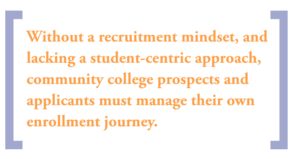Unless you’ve been living in a cave for the past few years, you are probably very aware of the chronic community college enrollment decline that has prevailed now for years. I find the enrollment demise ironic in the face of several states making a community college more accessible via low or no tuition and the Biden administrations’ call for “free college” for all.
So why are community colleges suffering? It certainly isn’t a cost or affordability issue.
Is it demographics? We do know that high school enrollments are declining in some states – but if you align the high school numbers with the CC numbers, you’ll have to abandon that hypothesis as the 2-year college enrollment decline is out-pacing the high school graduate population slide.
Well, what’s the reason? And what can Community Colleges do?
Let’s unpack a few reasons impacting enrollment – and look at some simple solutions. For the last two years I’ve worked closely with several community colleges to research their student journey via mystery shopping. Secret shopping is popular with private sector colleges and is very pervasive in the customer service space. Inspecting the admissions process through the
prospective student eyes has fueled some revealing observations in the 2-year public sector space.

Reason #1: Large National Brands are More Student Centric
One of the challenges of shopping community colleges is speaking to a knowledgeable staff member. This is in stark contrast to the large online schools we shop – and that you see advertising for. Not sure what I’m referring to? Do this:
Submit an inquiry for Large National Brand vs. Local Community College
What happens?
- You get an autoresponder thanking you for your interest.
- You get a phone call – RIGHT AWAY – from a knowledgeable staff member who happily walks you through the enrollment process.
What happens?
- NOTHING
- No call for sure
- Maybe an email. Maybe.

Reason #2: Large National Brands Have a Recruitment Mindset
Years ago, I would challenge the admissions team at the tuition-driven private, not for profit college where I worked with the
question: “Are you enrolling students or recruiting students?” My question was not always received well – but the point is this…
Recruitment is Active. Enrollment is Passive.
Enrollment officers review applications, screen out the individuals not qualified, and offer admission to a select few. On the flip side recruiters embrace the prospect, are available to answer questions, guide the process and encourage the individual to take the next step.
Unfortunately, somewhere along the line, the community college admissions teams have morphed into “enrollment officers.” Maybe its organized labor driving a passive approach. Or it could be that leadership worked at selective admissions schools and applied their process to the open-enrollment community college systems. It may be a staffing issue with not enough personnel to offer service. Whatever the underlying reasons are, the result is the same. There’s a glaring difference in mindsets at public 2-year colleges and their big-brother on-line national brands.

Reason #3: Less Friction = More Enrollments
It’s hard to navigate the student journey at a community college. Especially for first-generation college students. The friction is real. Look at what some of our shoppers said in answer to the question, “Based on your experience in the first 30 days after submitting your application, would you recommend this school to a friend?”
“I would not particularly recommend this school because I had a difficult time figuring out the status of my application and what I was supposed to do next. I had to reach out to the school myself to learn that I was missing a prerequisite and needed to take an entrance exam. I applied for the Business program but got accepted to Individual Studies instead, which I also would not have known about if I hadn’t called to speak with an advisor. I wish the school had been more proactive in giving me all this information.”
“Based on my experience with this school in the last few weeks, I would not be likely to recommend it to a friend. The communication from this school was extremely lacking. I was never updated by Admissions as to the status of my application or notified whether or not I had been accepted to the school.”
“I had the most frustrating experience with this school because it was really hard to get in touch with anyone over the phone. I did not receive any concrete response from them regarding my application status, so I reached out to Admissions. During the call, I was told that I needed to wait until the end of the day or the next day to get my application accepted. I tried to contact the school a few more times to get updates, but no one was available in the office.”

The Conclusion – It’s Simply the Service.
It’s clear to me why the large national brands are flourishing compared to their community college colleagues.

Without a recruitment mindset, and lacking a student-centric approach, community college prospects and applicants must manage their own enrollment journey. For a first-time college student that journey can be confusing. And without encouragement and guidance the friction may be overwhelming.
Which means the prospective student and applicant will abandon their journey and look for solutions elsewhere.
If community colleges want to thrive and increase enrollment, they will need to borrow several pages from their private college competition’s playbook. This means developing a contact strategy to communicate personally and in multiple modalities with prospects and applicants. It also necessitates mapping the student journey and eliminating as much friction as possible.
Free college or affordable tuition will never increase enrollment if the student can’t figure out how to enroll, what program is best for them, and what classes to take.
It’s not the cost. It’s the service.
Comments are closed.



Recent Comments